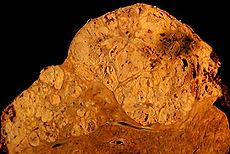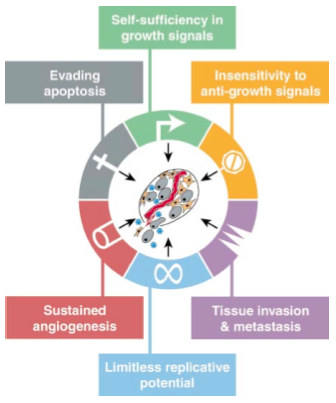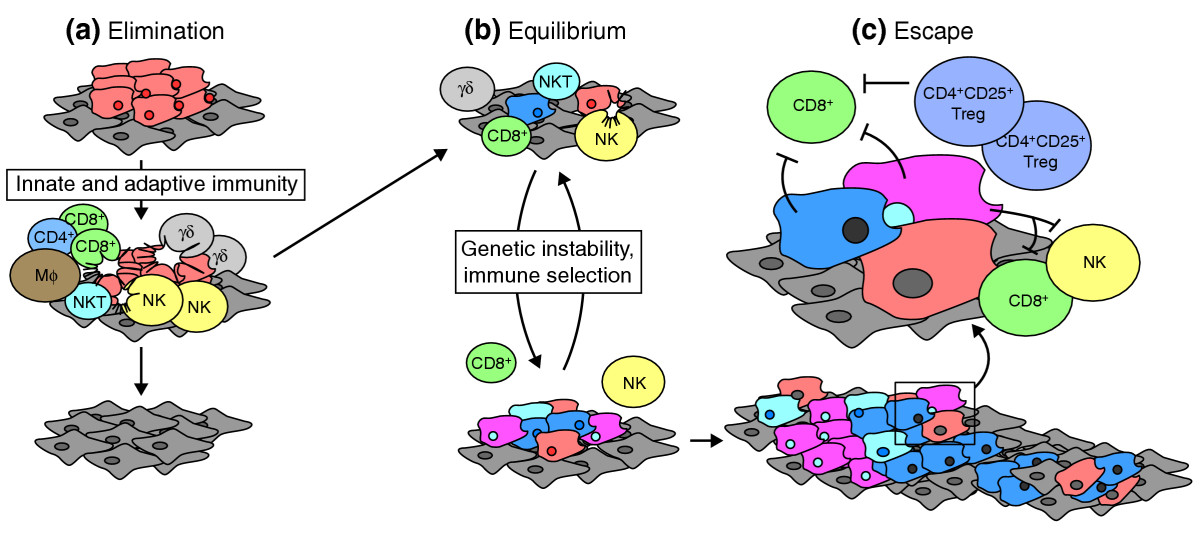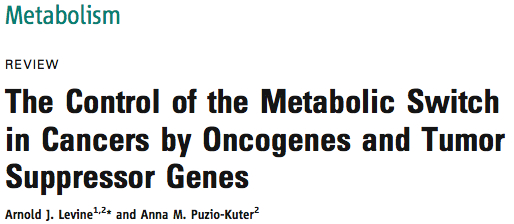In Nature Genetics last month, Yasushi Totoki and colleagues present the high-resolution characterization of hepatocellular carcinoma (HCC), the third most frequent cause of cancer-related death worldwide. The authors performed whole-genome sequencing (Illumina 2×50 bp) of the primary tumor (36x) and matched lymphocytes (28x) from a Japanese male with hepatitis C virus-positive liver cancer.

HCV-positive HCC tumor (Wikipedia)
The epidemiology of this type of cancer is quite interesting. Although relatively rare in the United States, HCC is one of the more common tumors world-wide, accounting for 662,000 deaths annually (half of which are in China). Males are affected more often than females, and most patients are 30 to 50 years old. Importantly, the majority of HCC cases are diagnosed in individuals with chronic hepatitis B or C infections or cirrhosis of the liver, suggesting that inflammation plays an important role in carcinogenesis (see my post on cancer-related inflammation).
Patterns of Somatic and Germline Substitution
Totoki et al predicted some 11,731 somatic substitutions (through a filtering/subtraction method) genome-wide. The most prevalent substitutions were C <-> T and G <->A transitions. The authors suggest that an excess of C/G to T/A transitions may be the mutational signature of HCV-associated cancers; it is consistent with previous reports that HCV infection introduces error-prone DNA polymerases that preferentially cause this type of transition. Interestingly, the rate of T to C (or A to G) transition was significantly decreased in coding exons relative to intergenic sequences, providing more evidence for transcription-coupled repair in evolving cells. In further support of this notion, the authors report that there were fewer T to C transitions on transcribed strands than untranscribed strands.
In the normal genome, there were 3.02 million germline SNPs, of which 90% were known to dbSNP. The prevalence of SNPs in coding exons was significantly less than in non-coding exons, likely reflecting negative selection against protein-altering mutations. Intriguingly, this pattern did not hold for somatic substitutions in the tumor, suggesting that the selective pressure was not as strong. To me, this seems entirely plausible if one considers that the somatic mutations occurred in a single tissue (liver) in a man who presumably survived birth, infancy, and childhood. It stands to reason that a germline variant affecting developmental pathways or other tissues might be selected against in a fetus, but still tolerated in a liver cancer cell.
Somatic Mutations and Rearrangements
In coding regions, the authors validated 81 somatic substitutions (63 non-synonymous, 18 synonymous) and 7 somatic small indels by capillary sequencing. Among the affected genes were two known HCC tumor-suppressors (TP53 and AXIN1) and five genes (ADAM22, JAK2, KHDRBS2, NEK8, and TRRAP) previously reported to be mutated in other tumors in the CoSMiC database. The TRRAP gene sounded familiar, and when I checked my EndNote library, I found a recent study in which exome sequencing (Wei et al) of 14 melanoma tumors had identified a recurrent mutation in TRRAP, and functional evaluations supported an oncogenic role for this gene.
The authors also predicted 33 somatic rearrangements using paired-end information; of these, 22 were validated by capillary sequencing of the breakpoints in both tumor and normal samples. Most validated SVs were intra-chromosomal and occurred at the boundary of copy number changes. Notably, nine somatic SVs were clustered at 11q12-13, generating “a complex pattern of chromosomal amplification and loss.” What the authors do not seem to realize is that this is almost certainly chromothripsis, a recently-characterized phenomenon in many tumors in which part of a chromosome is shattered and stitched back together (seemingly in random order) by DNA repair machinery.
Exome Sequencing Nabs Additional Mutation
Totoki et al also performed whole-exome sequencing (Agilent SureSelect) on the same samples. Using exome data, they identified 39 of the 63 validated non-synonymous mutations (63%). This sensitivity seems lower than what I’d expect, and I wonder if coverage or the mutation calling approach contribute to this. On the bright side, using exome data the authors identified an additional somatic mutation that was missed by WGS – a low-frequency (13%) nonsynonymous substitution in TSC1. This is a member of the mTOR pathway and a key tumor suppressor. While the relatively low frequency of this mutation suggests that it may not be a driver event, it may represent a therapeutic target for HCC. Further, its finding serves to demonstrate the benefits of high-coverage exome data.
References
Totoki Y, Tatsuno K, Yamamoto S, Arai Y, Hosoda F, Ishikawa S, Tsutsumi S, Sonoda K, Totsuka H, Shirakihara T, Sakamoto H, Wang L, Ojima H, Shimada K, Kosuge T, Okusaka T, Kato K, Kusuda J, Yoshida T, Aburatani H, & Shibata T (2011). High-resolution characterization of a hepatocellular carcinoma genome. Nature genetics, 43 (5), 464-9 PMID: 21499249
Wei X, Walia V, Lin JC, Teer JK, Prickett TD, Gartner J, Davis S, NISC Comparative Sequencing Program, Stemke-Hale K, Davies MA, Gershenwald JE, Robinson W, Robinson S, Rosenberg SA, & Samuels Y (2011). Exome sequencing identifies GRIN2A as frequently mutated in melanoma. Nature genetics, 43 (5), 442-6 PMID: 21499247


